2018 Ducati Multistrada 1260 First Ride Review + Video

A Ducati for nearly everyone and everything
I can feel the hair raise on the back of my neck as a smile stretches across my face. The beautiful cacophonous uproar of 20 Ducati Multistradas sitting, waiting to dance their way up the ancient volcano we are standing on. Here we are on Gran Canaria for the introduction of the 2018 Ducati Multistrada and, to be honest, I don’t think the smile has left my face since.
2018 Ducati Multistrada 1260
| Engine | 18.0/20 |
| Suspension/Handling | 14.5/15 |
| Transmission/Clutch | 9.0/10 |
| Brakes | 9.5/10 |
| Instruments/Controls | 4.5/5 |
| Ergonomics/Comfort | 9.0/10 |
| Appearance/Quality | 9.0/10 |
| Desirability | 9.0/10 |
| Value | 7.75/10 |
| Overall Score | 90.25/100 |
Until more recently, the long-legged sportbike often found itself lumped into what we all called the adventure-touring segment, a class of bikes many use as a catchall for tall touring or sport-touring motorcycles as well as more dirt-bound ADVs. As of late there have been more tall sport-tourers being put into production, enough that people are starting to refer to them as what they are. We’ve described such devices as belonging in a Sports Adventure Touring category, as we did in this epic nine-bike shootout from 2015.
Ducati, until the release of the Multistrada Enduro, had kept its focus with the Multistrada 1200 and previous iterations as being sport-touring tools. Don’t let its tall stance fool you. The Multi has and continues to be, a raucous, rip-roaring sportbike with all-day comfort and in typical Ducati fashion, an incredibly precise-handling motorcycle for its size.
Get the Flash Player to see this player.
While the 2018 Multi looks quite similar to the previous model, one of the biggest changes is all in the name. The Multistrada 1260 carries over the Testastretta 1262cc DVT (Desmodromic Variable Timing) engine found in the XDiavel with some slight mechanical changes and revised fuel mapping bringing the torque output slightly higher in the rev range. The new engine is said to deliver 85% of its torque at 3,500 rpm and 18% more torque under 5,500 rpm compared to its 1200cc predecessor. At a claimed 158 hp at 9,500 rpm, it’s purportedly two ponies down on last year’s model. Maximum torque also shows up in the negative at 95.5 lb-ft, down from 100.3 lb-ft in 2017, according to Ducati.
2015 Ducati Multistrada 1200 And 1200S First Ride Review + Video
The crew in Bologna has put a lot of time and thought into how to make the Multistrada 1260 appeal to a broader audience, that’s why it was decided to bring the XDiavel engine over to the Multistrada 1260.
“It gives us the best of both worlds,” says Federico Valentini, Ducati project manager of the Multistrada and Hypermotard lines (as well as of the Superleggera 1299). “It gives us torquier, strong power delivery down low, which makes it easily able to pull higher gears even with a passenger and luggage on board, but it also gives you that sportier hit. It’s the touring and the sports aspect of the bike.”
2016 Ducati XDiavel S First Ride Review
After having a chance to ride the new Multistrada, I couldn’t agree more. With the launch of this motorcycle taking place on the Spanish Canary Islands off the coast of Morocco, it was quickly evident just how low down you could lug the motorcycle while still having plentiful torque quickly available.
Gran Canaria is more or less a massive 9-million-year-old volcano with challengingly tight, off-cambered switchbacks of serpentine asphalt snaking its way around the island. To say the ride was exhilarating would be an understatement. When coming into a corner hard on the Brembo M50s that we have come to love on superbikes (found on the Multistrada S and Pikes Peak models), it was easy to stay in the gear you had selected and just let the motorcycle dig down low into the torque range and get back hard on the gas as the 1262 DVT engine would slingshot you toward the next apex.
I might have liked to test the Multi 1260 in a more diverse set of roads rather than only tight, twisty sections where higher gears were never needed, but it was a chance to show off the strong points of the engine and undoubtedly the reason Ducati chose the route.
Continuing with its revisions for 2018, Ducati has increased the swingarm length by 1.9 inches as well as increasing its rake by 1 degree and trail by 0.2 inches resulting in a 2.2 inch increase in the overall wheelbase of the motorcycle. These changes are said to enhance high-speed stability of the motorcycle when loaded with a passenger and luggage. Being on a relatively small island during the ride with few straight sections of road, I can’t attest to the stability at autobahn-like speed, but I can say that it performs really well while hustling through the corners.
The handling of the Multistrada 1260 is superb for a motorcycle of its size. At a claimed 511 lbs wet and with a 62.4-inch wheelbase, I was pleasantly impressed with how precise and light the front end felt and how quickly the entire motorcycle could be flicked from side to side. The S model we rode during our test is equipped with Ducati’s Skyhook Suspension Evo, which works in conjunction with the Bosch IMU to adjust the semi-active suspension over varying terrain. The IMU is also what controls the self-canceling turn signals. Fancy.
User adjustability is more tunable and intuitive than before, thanks to the reworked layout featured on the new higher-resolution, auto-contrasting display. Ride modes are easily selected and offer default configurations for suspension, DTC (Ducati Traction Control), Anti-lock Brakes, DWC (Ducati Wheelie Control), and engine power output. All of the aforementioned settings can easily be changed from their defaults, giving the rider complete control in how they want to use the motorcycle at any given point in time.
When switching between modes, and in turn, suspension settings among other electronics changes, I found touring and urban to be softer than I would like during our quick pace though extremely curvy roads. Touring mode smooths out the throttle response while still offering all 158 horses and backs off preload to give a more plush ride, while Urban cuts horsepower output to 100 hp and preload back to 4, a full 10 levels down from sport.
Enduro also cuts horsepower to 100 and adjusts the suspension to a more off-road-oriented setting while turning down DTC, DWC, and ABS (ABS is turned off for the rear wheel). Sport mode was unequivocally the preferred setting for our ride and could be easily tweaked from the settings menu. Throttle response was sometimes harsh, but the suspension handled with aplomb at the default settings.
Furthering the rider interface with the motorcycle, DQS (Ducati Quick Shift) Up & Down is now equipped on both S and Pikes Peak models. As usual, the quickshifter works best at higher rpm, while downshifts are accomplished when the lever is given a forceful shove; not the smoothest I have used, but it does the job.
A new ride-by-wire system is also said to offer smoother throttle control, and while it did feel smoother in most situations, I was surprised by an abruptness in tight corners when coming off the throttle at low rpm. Keeping the motorcycle spun up higher in the rev-range seemed to alleviate this problem and it was most noticeable in Sport mode. After speaking to others on our ride, a few journos mentioned they had noticed it somewhat, but it didn’t seem to bother anyone. Maybe it was just me.
I know what you’re thinking now: I want more acronyms! Here you go: Not yet mentioned, the 2018 Ducati Multistrada 1260 comes complete with: VHC (Vehicle Hill Control) for when you find yourself stopped on the side of a volcano perhaps; DCL (Ducati Cornering Lights) LED lights that point toward the inside of your turn while circumnavigating said volcano; DMS (Ducati Multimedia System) which allows you to listen to DMX on your linked Bluetooth device and also receive TXT messages all on the dash; and last but not least, TPMS (Tire Pressure Monitoring Sensor) which is an optional accessory on all 2018 Multistrada models. Whew. Still with me? Okay, let’s move on.
The technology doesn’t stop there. The new Ducati Link App, available in February 2018, will give Multistrada 1260 owners an all new way to interact with their motorcycle as well. When connected via bluetooth, the app can record lean angle, current, average, and max speed, power, and fuel consumption. In typical fashion these days, the app also allows you to record routes and share them in a community of Ducati Link app users, earn points and badges for miles ridden, events attended, etc., and alerts you to the wonderfully long service intervals when they are due.
Maybe my favorite feature of the app is the ability to set riding mode parameters with additional information as to how they affect the motorcycle. When you’re finished with your setup, you can link the motorcycle via bluetooth and it will plug in the settings you have selected. What a world we live in.
Four additional equipment packages are available as before: Touring includes heated grips, center stand, and color-matched panniers. Sport includes a Termignoni slip-on, carbon fiber mudguard, and billet aluminum brake and clutch reservoir caps. Urban gets you a top case, tank bag with lock, and USB hub. Enduro includes auxiliary lights and Ducati performance components by Touratech, such as engine protection bars, radiator guard, oil sump guard, a larger kickstand base and off-road footpegs.
While the laundry list of acronyms and options are dizzying, the amount of adjustability is astonishing. Ducati likes to say the Multistrada is four bikes in one. The 2018 Multi is a fantastic motorcycle that can certainly pull double duty or even triple duty as a sportbike, touring motorcycle, and a commuter ride, but I think I’ll leave the enduro job to the Ducati with Enduro in its name. I thoroughly enjoyed my time spent on the Multistrada 1260 and look forward to getting my hands on one at home back in California. Kudos to Ducati for creating an incredibly versatile motorcycle and continuing to improve upon an already formidable sport-tourer with emphasis on the sport.
2018 Ducati Multistrada 1260 Specifications | ||||
|---|---|---|---|---|
Multistrada 1260 | Multistrada 1260 S | Multistrada 1260 Pikes Peak | ||
| Engine Type | Ducati Testastretta DVT with Desmodromic Variable Timing, L-Twin cylinder, 4 valve per cylinder, Dual Spark, liquid cooled | |||
| Displacement | 1.262 cc | |||
| Bore x Stroke | 106 x 71.5 mm | |||
| Compression Ratio | 13:1 | |||
| Power | 158 hp at 9,500 rpm (claimed) | |||
| Torque | 95.5 lb-ft at 7,500 rpm (claimed) | |||
| Fuel injection | Bosch electronic fuel injection system, elliptical throttle bodies with Ride-by-Wire, equivalent diameter 56 mm | |||
| Exhaust | Stainless steel muffler with catalytic converter and 2 lambda probes, aluminum tail pipes | |||
| Gearbox | 6 speed | |||
| Gear Ratios | 1=37/15 2=30/17 3=27/20 4=24/22 5=23/24 6=22/25 | |||
| Primary Drive | Straight cut gears; Ratio 1.84:1 | |||
| Final drive | Chain; Front sprocket 15; Rear sprocket 40 | |||
| Clutch | Light action, wet, multiplate clutch with hydraulic control. Self-servo action on drive, slipper action on over-run | |||
| Frame | Tubular steel Trellis frame | |||
| Wheelbase | 62.4 in | |||
| Rake | 25° | |||
| Trail | 4.37 in | |||
| Front Suspension | 48 mm fully adjustable usd forks | Sachs 48 mm fully adjustable usd forks. Electronic compression and rebound damping adjustment with Ducati Skyhook Suspension Evo (DSS) | Öhilins 48 mm fully adjustable usd forks | |
| Front Wheel Travel | 6.7 in | |||
| Front wheel | 5-spoke Y-shape cast light alloy 3.50″ x 17″ | 5-spoke Y-shape cast light alloy 3.50″ x 17″ | 3-spoke Ѱ-shape forged light alloy 3.50″ x 17″ | |
| Front Tire | Pirelli Scopion Trail II 120/70 R17 | |||
| Rear Suspension | Fully adjustable Sachs monoshock unit. Remote spring preload adjustment. Aluminum single-sided swingarm | Fully adjustable Sachs unit. Electronic compression and rebound damping adjustment. Electronic spring pre-load adjustment with Ducati Skyhook Suspension (DSS) Evo. Aluminum single-sided swingarm | Fully adjustable Öhlins TTX36 shock absorber. Aluminum single-sided swingarm | |
| Rear Wheel Travel | 6.7 in | |||
| Rear Wheel | 5-spoke Y-shaped cast light alloy 6.00″ x 17″ | 5-spoke Y-shaped casted light alloy 6.00″ x 17″ | 3-spoke Ѱ-shape forged light alloy 6.00″ x 17″ | |
| Rear Tire | Pirelli Scorpion Trail II 190/55 R17 | |||
| Front Brake | 2 x 320 mm semi-floating discs, radially mounted monobloc Brembo callipers, 4-piston, 2-pad, with cornering ABS as standard equipment | 2 x 330 mm semi-floating discs, radially mounted Brembo monobloc Evo M50 4-piston callipers, 2-pad, radial pump with cornering ABS as standard equipment | 2 x 330 mm semi-floating discs, radially mounted Brembo monobloc Evo M50 4-piston callipers, 2-pad, radial pump with cornering ABS as standard equipment | |
| Rear Brake | 265 mm disc, 2-piston floating calliper, with cornering ABS as standard equipment | |||
| Fuel Tank Capacity | 20 l – 5.3 gallon (US) | |||
| Dry weight | 461 lb (claimed) | 467 lb (claimed) | 454 lb (claimed) | |
| Wet weight | 511 lb (claimed) | 518 lb (claimed) | 505 lb (claimed) | |
| Seat height | Adjustable 825 – 845 mm (32.5 – 33.3 in) | |||
| Instrumentation | LCD | Color TFT display 5″ | Color TFT display 5″ | |
| Ducati electronics | Vehicle Hold Control (VHC), Riding Modes, Power Modes, Ducati Safety Pack (Bosch Cornering ABS + DTC), Ducati Wheelie Control (DWC), Cruise control, Hands-Free, Backlit handlebar switches, Auto-off indicators, ready for Ducati Quick Shift (DQS) up/down, Ducati Multimedia System (DMS), Anti-theft system | Vehicle Hold Control (VHC), Riding Modes, Power Modes, Ducati Safety Pack (Bosch Cornering ABS + DTC), Ducati Wheelie Control (DWC), Ducati Cornering Lights, Ducati Skyhook Suspension (DSS) Evo, Ducati Quick Shift (DQS) up/down, Cruise control, Hands-Free, Backlit handlebar switches, Ducati Multimedia System (DMS), Full-colour TFT display, Full LED headlamp, Auto-off indicators, ready for Anti-theft system | Vehicle Hold Control (VHC), Riding Modes, Power Modes, Ducati Safety Pack (Bosch Cornering ABS + DTC), Ducati Wheelie Control (DWC), Ducati Cornering Lights, Ducati Quick Shift (DQS) up/down, Cruise control, Hands-Free, Backlit handlebar switches, Ducati Multimedia System (DMS), Full-colour TFT display, Full LED headlamp, Auto-off indicators, Ducati Performance by Termignoni homologated exhaust, Carbon fibre windscreen, High performance Öhlins suspension, Carbon fibre front mudguard, Carbon fibre side panels and Hands-Free cover, Forged wheels, ready for Anti-theft system | |
| Fuel Consumption | 45.23 mpg (claimed) | |||

Ryan’s time in the motorcycle industry has revolved around sales and marketing prior to landing a gig at Motorcycle.com. An avid motorcyclist, interested in all shapes, sizes, and colors of motorized two-wheeled vehicles, Ryan brings a young, passionate enthusiasm to the digital pages of MO.
More by Ryan Adams



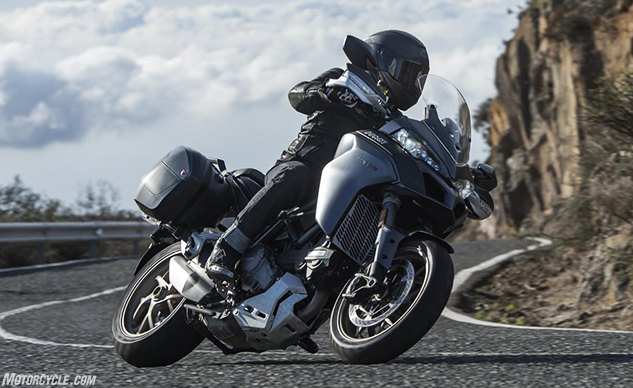
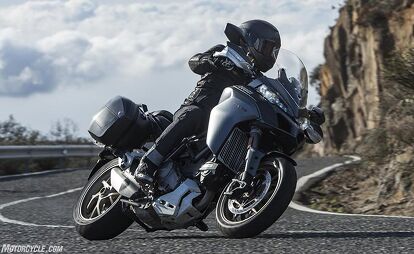


















































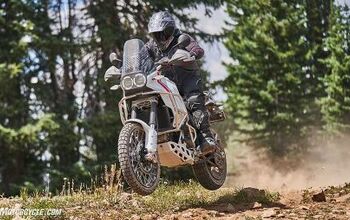

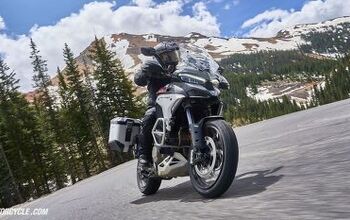

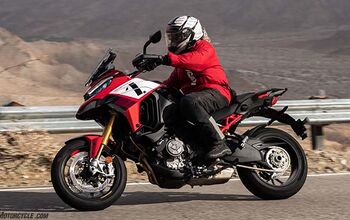
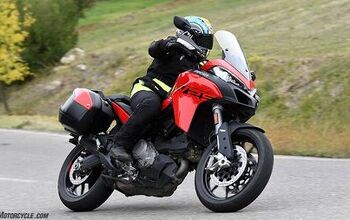











Comments
Join the conversation
Why are all the reviews for this bike touting the cornering lights and Bluetooth link as new features? My 2106 Touring S has both!
I love my 1260S Touring in white. But I must admit that beak is imposing.
https://uploads.disquscdn.c...